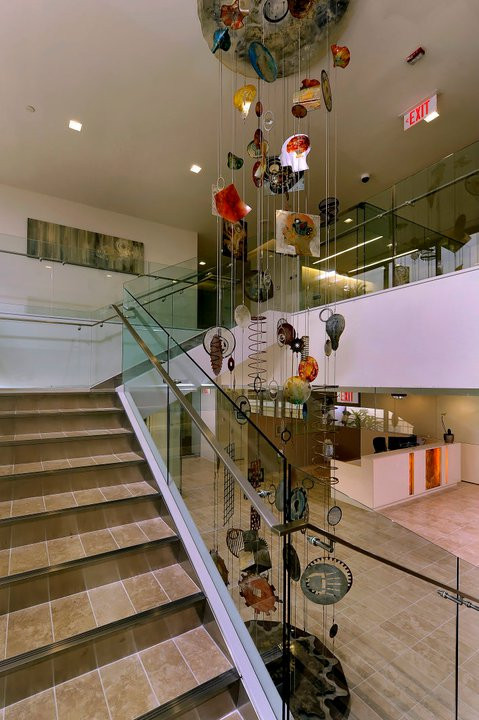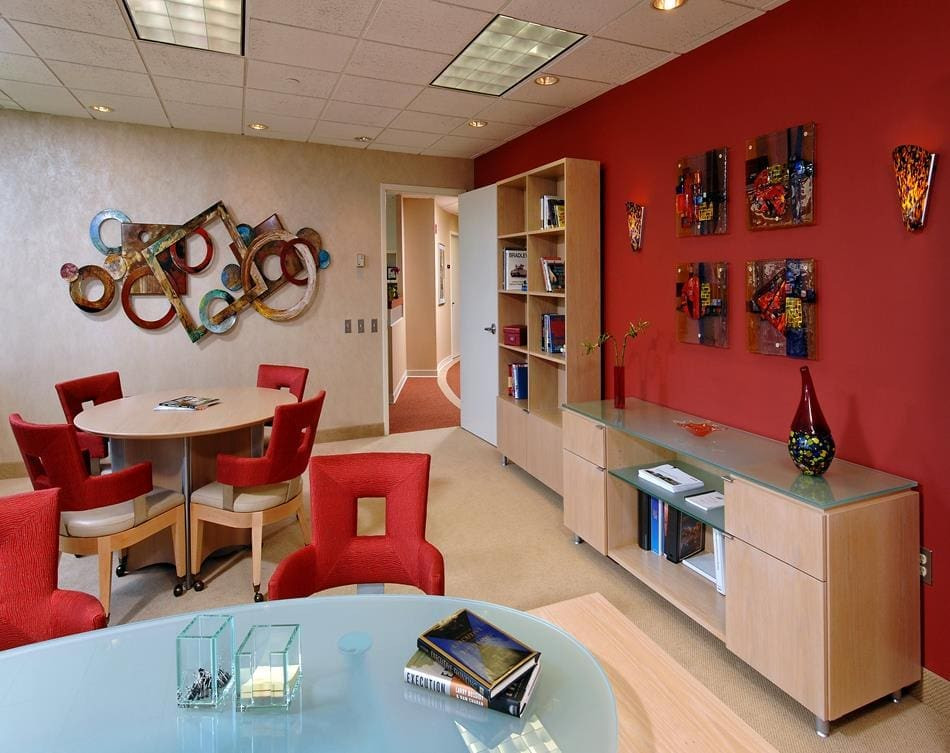How Interior Design Washington DC Businesses Appreciate Enhances Team Creativity and Productivity
Fairfax Station, United States - March 17, 2025 / Shea Studio Interiors, Inc /
Why Do Businesses Invest in Interior Design Washington DC Services?
Color has an undeniable influence on mood, behavior, and interaction, especially in corporate settings. As businesses seek to optimize the well-being and performance of their teams, many are turning to interior design Washington DC specialists to harness color psychology as a strategic element in their commercial spaces. In a diverse region that includes bustling downtown corridors and suburban hubs, local experts understand how color can enhance functionality and expression in ways that transcend mere aesthetics. This insight holds equally true on the outskirts of the city, where northern Virginia interior design experts cater to organizations eager to create visually stimulating environments that also support employee engagement.
In this press release, Shea Studio Interiors delves into how color affects productivity, creativity, and overall workplace satisfaction. Readers will discover why a carefully curated palette extends beyond decorative appeal, shaping how employees feel and perform. Whether an office is located near Capitol Hill (20002), close to Dupont Circle (20036), or in the rapidly developing suburbs of Arlington (22201), color psychology can become a powerful resource for businesses looking to reflect their brand identity and foster a culture of innovation.
What Challenges Drive the Need for Interior Design Washington DC Businesses Are Looking For?
In a bustling metropolitan area like Washington, DC, establishing a workspace that stands out is more important than ever. Companies often invest heavily in design elements to communicate professionalism and uniqueness. Yet many overlook the nuanced role that color selection plays. Interior design Washington DC experts emphasize that colors are more than stylistic choices; they are tools that can influence mood, cognitive function, and interpersonal dynamics. By leveraging color psychology, organizations can boost creativity, inspire collaboration, and enhance a sense of belonging among employees.
Outside the city’s core, in areas like Alexandria (22314) and Falls Church (22046), businesses face similar challenges. Local organizations often seek northern Virginia interior design services to remain competitive and ensure that their spaces accommodate diverse work styles and brand narratives. It is no longer enough to have a workspace that just looks modern; it must foster well-being and productivity for today’s evolving workforce. By integrating color psychology principles—where specific hues are known to calm, energize, or stimulate thought—business owners can nurture an environment that draws in talent and supports long-term staff retention.
Many companies, however, remain unaware of how dramatically color can affect everyday interactions. Walls painted in dull, overly neutral tones might inadvertently quell imagination or make employees feel disconnected. Conversely, an overly vibrant or random assortment of hues can be distracting and clash with a company’s ethos. Whether an organization is rooted in the historical neighborhoods near the National Mall or spread across suburban office complexes, understanding the deeper emotional resonance of color is critical to establishing a design that resonates with employees and clients alike.
Examining Color Psychology in Today’s Interior Design Market
Why Is Color Psychology Important in Commercial Interior Design?
Color psychology studies how different shades trigger emotional and behavioral responses in human beings. In the workplace, these responses directly impact focus, creativity, and engagement. Within interior design Washington DC locals appreciate, professionals who specialize in commercial projects often use color as a subtle way to shape organizational culture. For instance, blue hues have been associated with calmness, trust, and analytical thinking—making them popular for law firms or financial institutions. Meanwhile, green can infuse a space with a sense of balance and renewal, suitable for health care providers or wellness startups.
On a practical level, color can also influence spatial perception. Lighter tones tend to make rooms feel more open and airy, while darker colors can lend an intimate or moody vibe. Thus, a commercial layout can be enhanced by recognizing how color palettes interact with lighting, furnishings, and architectural features. When executed skillfully, an interior design scheme can simultaneously reinforce a brand’s identity and energize the teams working within it.
How Do Color Palettes Affect Brand Identity and Employee Well-Being?
An effective brand strategy often extends into the physical space of a business—colors are central to that identity. A company that prides itself on stability might embrace understated, professional palettes. Alternatively, a start-up known for innovation might feature bold, vibrant hues. The way this brand identity resonates with employees is just as important as how it appears to clients. Workers who walk into an environment that visually reflects their organization’s ethos tend to experience heightened motivation and loyalty.
From a well-being perspective, color choice also helps mitigate workplace stress. Muted neutral tones, while professional, can veer toward monotony if not balanced with accent colors that provide visual relief. Some DC-based companies mix earthy greens with warm accents to create a grounded yet stimulating environment, reflecting both the region’s historical charm and modern drive. In northern Virginia, color palettes might be adapted to align with evolving suburban developments that incorporate parks, trails, and community centers. Linking the indoor environment with familiar local elements can reinforce employees’ sense of belonging.
What Is the Average Cost of an Interior Designer in DC?
Hiring a designer in Washington, DC can involve numerous variables. Rates fluctuate based on the size and complexity of the space, the intricacy of the desired color schemes, and the level of architectural or structural changes required. Typically, costs can be calculated as an hourly fee or as part of a project-based flat rate, factoring in design consultation, material sourcing, and ongoing project management. Highly specialized designers with a strong focus on color psychology may charge a premium, but this targeted expertise can yield a workspace that genuinely enhances productivity.
Commercial projects often involve additional considerations, such as adherence to building codes in historic districts. Businesses near the White House (20500), for example, might navigate stricter guidelines for preserving architectural features. Nonetheless, many companies consider the expense of a color-savvy design investment worthwhile. Whether it’s an established law firm in Foggy Bottom or a tech start-up in NoMa (20002), paying attention to color psychology can yield measurable returns in employee satisfaction and performance.
How Do I Choose an Interior Designer in Washington DC?
Selecting a designer requires balancing creative flair with a solid grounding in practical constraints. First, a potential client should review portfolios to see if the designer’s style resonates with the organization’s vision, especially if the project emphasizes color psychology. Second, it is helpful to ask about prior experience with commercial sites in Washington, DC or northern Virginia. Familiarity with local architectural styles and requirements often leads to smoother project execution.
Additionally, the best collaborations arise when both client and designer share open communication. Businesses should discuss concerns, brand values, and employee demographics with the prospective firm. This transparency helps a designer shape a plan that goes beyond superficial aesthetics. Checking credentials is also advisable—memberships in professional organizations such as the American Society of Interior Designers can attest to a designer’s commitment to industry standards and continuing education.
When Should Companies Update Their Color Schemes?
There is no fixed timeline for refreshing a workspace’s colors. Certain triggers may include rebranding efforts, organizational restructuring, or expansions that involve merging new employees and existing teams. Updates can also coincide with relocations or renovations, especially in areas where commercial leasing terms favor periodic improvements. Early planning is crucial—color selection should coincide with decisions about lighting and furniture to ensure a cohesive overall look.
In many instances, a simple yet targeted palette adjustment can rejuvenate a workspace. For example, a common area repainted in energizing tones may help spark creativity, while calmer hues in private offices or phone booths might encourage concentration. Firms near Georgetown (20007) or Rosslyn (22209) might leverage color choices that differentiate individual rooms, reflecting their dynamic mix of formal and collaborative spaces.
What Is the Difference Between an Interior Decorator and an Interior Designer?
The terms “interior decorator” and “interior designer” are sometimes used interchangeably but reflect distinct roles. Decorators typically focus on the selection of surface elements, such as color palettes, furniture, and accessories. Interior designers, by contrast, often tackle broader project aspects, which may include space planning, lighting design, and compliance with local building codes. For companies aiming to capitalize on northern Virginia interior design or DC-based services rooted in color psychology, working with a professional trained in both the aesthetics and functionality of space can yield the greatest impact.
In corporate environments, an interior designer typically coordinates with architects, engineers, and contractors, ensuring that each spatial decision supports the organization’s objectives. They use color psychology not as a finishing touch, but as an integral component of the design concept—balancing the desired emotional tone with practical constraints, such as traffic flow and acoustics.
Integrating Local Influences and Research
In Washington, DC—where political, cultural, and academic institutions converge—commercial design often reflects a blend of history and innovation. Businesses aiming to tie their interior concepts to local culture may draw on historical color palettes or incorporate themes from revered landmarks like the Smithsonian Institution. By blending local inspirations with scientific insights from organizations like the American Psychological Association, companies can create designs that feel both modern and contextually rich.
Similarly, offices in northern Virginia areas, from Tysons (22102) to Reston (20190), can benefit from color schemes that reference the region’s mix of urban and natural settings. Drawing on elements from nearby parks, government sites, or cultural venues can give employees a sense of connection to the broader community. Strategic design decisions that reinforce local character often resonate with staff, translating into higher morale and a more grounded sense of place.
Is There Proof That Interior Design Improves Workplace Performance?
Research has consistently indicated that color can influence concentration levels. A study discussed by the American Psychological Association demonstrated that employees in well-designed, color-coordinated offices exhibited a measurable boost in job satisfaction and productivity compared to those in bland or overly monochromatic environments. Meanwhile, Shea Studio Interiors has received positive testimonials from clients who noticed an uptick in creativity and reduced stress when introducing vibrant accent walls in brainstorming areas.
One northern Virginia tech company that overhauled its main conference rooms with carefully chosen blues and greens saw improved feedback on team surveys regarding collaboration and focus. According to the client, employees felt “more invigorated and comfortable” in the newly designed spaces. Another commercial client near Dupont Circle commended the “cohesive energy” that emerged after aligning interior details with both their brand colors and scientifically grounded hues known to stimulate mental clarity. These success stories illustrate how combining northern Virginia interior design expertise with color research can achieve tangible results in the workplace.
Interior Design FAQs
Why is color psychology important in commercial interior design?
Color impacts mood, concentration, and creativity. By choosing hues strategically, businesses can create work environments that promote employee well-being, align with brand identity, and boost productivity.When should companies update their color schemes?
Many choose to refresh palettes during rebranding, expansions, or leadership changes. A new color scheme can reinvigorate the workspace, reflecting fresh goals and boosting morale.How do I choose an interior designer in Washington, DC?
Look for a proven track record, local expertise, and knowledge of color psychology. Communicating your brand values and goals ensures the designer’s vision aligns with your needs.What is the difference between an interior decorator and an interior designer?
Decorators concentrate on aesthetics—like color and furnishings—while interior designers handle a broader scope, including space planning and building codes, often integrating color psychology for optimal results.
How Can Organizations Harness Interior Design in Washington DC for Growth?
Shea Studio Interiors invites local businesses to explore how color psychology can revolutionize their commercial interiors, whether in the heart of DC or throughout its sprawling suburbs. By embracing interior design Washington DC businesses appreciate that integrate both style and science, companies can cultivate work environments more conducive to creativity, productivity, and staff well-being. It begins with a consultation that maps out how brand values, architectural features, and color theory intersect. From there, a customized proposal may incorporate everything from accent walls and lighting adjustments to furniture selections that reinforce the intended emotional impact of the space.
In planning new or updated environments, businesses should consider how employees react to existing color schemes. Are there areas where productivity lags or energy dips at certain times of the day? Might a collaborative zone benefit from uplifting tones, while private workstations adopt more soothing hues? By digging into these insights, companies can design spaces that speak to both business goals and the personal needs of employees. This holistic approach can also guide decisions about modular layouts or adjustable elements, ensuring that workplace design stays flexible and future-proof.
Further inspiration can be gleaned from community resources, such as local arts councils or design associations that champion innovative aesthetics. Strategic color choices, when aligned with an organization’s mission, can transcend temporary trends. They become a framework that fuels employee engagement and underscores a company’s forward-thinking posture—an especially valuable asset in the competitive, high-energy context of Washington, DC and its neighboring regions.
Who Offers Leading Interior Design Washington DC Expertise?
Shea Studio Interiors is a specialized firm dedicated to transforming residential and commercial environments throughout Northern Virginia and the Washington, DC Metro area. Their expertise lies in uniting contemporary design principles with practical considerations, ensuring clients receive balanced solutions that prioritize both form and function. Through thoughtful application of color psychology, space planning, and design trends, Shea Studio Interiors elevates spaces to foster productivity and creative innovation.
Collaborating with architects, builders, and business owners, Shea Studio Interiors develops interior schemes that harmonize brand identity with the unique character of each locale. Whether revitalizing an urban office near Capitol Hill or refreshing a suburban workspace along the I-495 corridor, the team consistently delivers designs that resonate with local culture. With an unwavering commitment to client satisfaction, Shea Studio Interiors stands at the forefront of design solutions that acknowledge the ever-evolving needs of modern businesses.
Where Does Interior Design Washington DC Go from Here?
Color psychology serves as a powerful component of workplace design in a region as multifaceted as Washington, DC. By tapping into interior design Washington DC companies need that incorporate scientific understanding of how hues affect mood and interaction, businesses can cultivate offices that strengthen brand identity and empower their teams. Those who align their color strategies with cultural references, community insights, and cutting-edge research stand to benefit from heightened employee engagement and client appeal.
Shea Studio Interiors remains dedicated to guiding clients at every stage of their design journey, leveraging a deep understanding of both local nuances and global style perspectives. Their comprehensive methodology—anchored in the synergy of color, functionality, and design—distinguishes them as a leader in transforming commercial environments. For organizations seeking to embrace color psychology as a cornerstone of workplace vitality, Shea Studio Interiors offers a strategic, results-driven approach that aligns aesthetics with measurable performance.

Contact Information:
Shea Studio Interiors, Inc
8302 Ivy Green Rd
Fairfax Station, VA 22039
United States
Leah Downs
(703) 891-1570
https://sheastudio.com/
Original Source: https://sheastudio.com/how-interior-design-washington-dc-businesses-appreciate-enhance-team-creativity-and-productivity/



